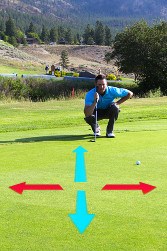
Understanding the Golf Term “Grain on a Green”
Golf is a sport that requires careful knowledge and understanding of various terms and elements. One such term is “grain on a green.” The grain refers to the texture or direction of the grass on a putting green. This texture can greatly influence the roll and speed of a golf ball, ultimately affecting players' putting game. Let's dive deeper into understanding the importance of grain on a green.
Key Points:
- The grain refers to the texture or direction of the grass on a putting green.
- Understanding the grain is crucial for accurate putting.
- Grain affects the roll, speed, and break of a putt.
- Various factors influence the direction of the grain.
- Observation and experience are necessary to read the grain correctly.
Effects of Grain on a Green:
The grain on a green can have a significant impact on how a golf ball rolls after it is hit. Understanding the grain is crucial for accurate putting. Here are a few effects of grain on a green:
- Roll: When a golf ball rolls against the grain, it tends to slow down and can cause the putt to come up short. On the other hand, when the ball rolls with the grain, it travels faster and covers more distance.
- Speed: The direction of the grain can affect the overall speed of a putt. Putting into the grain may require a firmer stroke to compensate for the resistance, while putting with the grain might require a lighter touch to avoid overpowering the roll.
- Break: The grain can also influence the break or the curve of a putt. Putts that cross the grain may break more, while those with the grain tend to hold their line better.
Factors Influencing the Direction of the Grain:
Several factors influence the direction of the grain on a green. Understanding these factors can help golfers determine the intended path of their putts:
- Sun Exposure: Grass tends to grow towards the sun. Therefore, greens with more sun exposure tend to have grain running from the dark to the sunny side of the green.
- Prevailing Wind: The wind can impact the growth of grass blades, causing the grain to align with the prevailing wind direction.
- Maintenance Practices: The mowing patterns and techniques used by the course maintenance team can also influence the grain on a green.
- Overall Green Slope: The grain can sometimes follow the natural slope of the green. Uphill putts may have a different grain direction compared to downhill putts.
Reading the Grain:
Reading the grain correctly requires observation and experience. Here are some tips to help you understand the grain on a green:
- Inspect the green from various angles to find any patterns or textures that indicate the direction of the grain.
- Look for shiny or darker areas, as they often indicate the direction the grass is growing.
- Take note of how the grass feels under your feet as you walk on the green. You might sense resistance in one direction, indicating the opposite direction of the grain.
- Observe other players' putts to gather insight into how the grain is affecting their rolls.
- Remember that grain tends to have a stronger impact on slower greens compared to faster greens.
- With time and practice, you'll develop a better feel for the grain and be able to make more accurate reads on the green.
Understanding the grain on a green is an essential aspect of golf. By grasping its effects and learning to read it, golfers can improve their ability to judge distances, speed, and break on the putting surface. Incorporate these tips into your game, and you'll be well on your way to becoming a more knowledgeable golfer.






